Nürnberg, – Lucas Cranach, – Albrecht Dürer, – Martin Luther
By Henning Høholt on 4/26/17 • Categorized as Art's,Festival,Tourism
Nürnberg –
Lucas Cranach, Albrecht Dürer, Martin Luther
Visited by Henning Høholt, text and photos
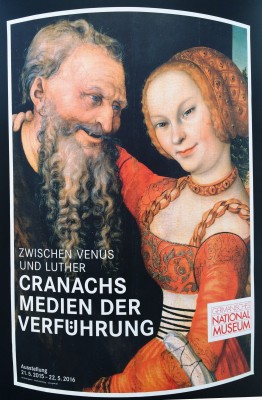
Lucas Cranach, poster , Imidlertid avslører denne poster ikke den fulle og hele sannheten, som hele maleriet viser, og som de to personers blikke forteller om. Utstillingen kan sees i Germanisches National Museum. foto Henning Høholt 2015
NÛRNBERG/GERMANY: In year 2015 it was the celebration of one of the most famouse German painters Lucas Cranac the younger.
14th October 2015, was celebrating 500 years of his birthday, it was marked all over Germany
. Lucas Cranach the Younger (1515-1586) – the second son of painter Lucas Cranach the Elder (1472-1553) – would have been 500 years old on 4th October 2015.
With the exception of Albrecht Dürer, Cranach the Elder and the Younger are considered the most significant painters and printmakers of Renaissance in Germany.
Their entire oeuvre is estimated at around 5,000 paintings, including famous portraits of Martin Luther, Katharina von Bora, Philipp Melanchthon and other reformers and princes of the Reformation period.
Martin Luther 500 years 2017

Reformation: In Year 2017 it is 500 years since Martin Luther hang up his 95 betydningsfulle teser at the church door in Wittenberg. –
Posthum portrait of Martin Luther as Augoustiner Monk by the Cranach studio. 1546. At Germanisches National Museum Nürnberg. Foto: Henning Høholt.
As part of the Martin Luther Decade, whose focus in 2015 was the topic of “Picture and Message” the German National Tourist Board (GNTB) was using that anniversary to celebrate various themes: the figure of Lucas Cranach the Younger, the works of father and son, and the numerous international exhibitions and events commemorating “Cranach Year”.
In 2017 it is the celebration of the Reformation, I 2017 it is 500 år since Martin Luther presented his 95 important texts at the church door in Wittenberg.
More about the Reformation will follow.
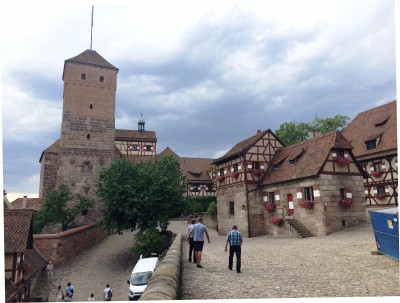
Emperor Castle, Nürnberg, Foto Henning Høholt,
The Imperial Castle in Nürnberg
is the symbol of Nuremberg. Since the Middle Ages its silhouette has represented the power and importance of the Holy Roman Empire of the German Nation and the outstanding role of the imperial city of Nuremberg.
In 1945 practically the entire Imperial Castle lay in ruins, but important Romanesque and late Gothic sections survived virtually unscathed. Immediately after the war, Rudolf Esterer rebuilt the complex almost exactly as he had before the war on the principle of “creative conservation”.
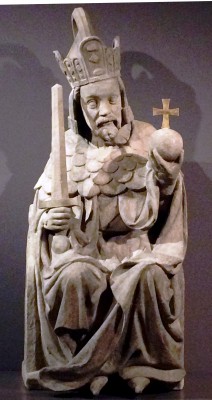
Emperor in the Fortress in Nürnberg,
The permanent exhibition in the castle was redesigned by the Bavarian Palace Department together with the Nuremberg museums in 2013.
The new concept shows not only clear explanations of the elements and function of the castle in their historical context, but also presents information about the Holy Roman Empire of the German Nation and the role of Nuremberg in the late Middle Ages in a vivid and exciting form that will appeal to visitors of all ages.
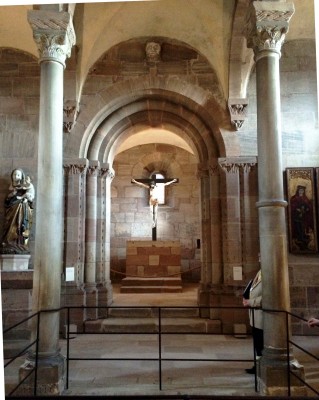
Imperial Chapel, Nürnberg Castle,
“Germany is one of the world’s most important cultural destinations and an artistic anniversary such as this is a great way to further cement our status as a land of culture,” explains Petra Hedorfer, CEO of the GNTB “
In terms of cultural trips made by European travellers in 2013, Germany was number one with a market share of twelve per cent.”
Two years before the anniversary of the Reformation, this cultural theme is also an important part of this decade’s focus.
Twelve stages of a life – “Paths to Cranach” Twelve of the key places in Bavaria and central Germany in which the Cranach family of painters lived and worked have formed the “Paths to Cranach” partnership: Kronach, Coburg, Nuremberg, Neustadt an der Orla, Weimar, Erfurt, Gotha, Eisenach, Dessau, Wittenberg, Meissen and Schneeberg are celebrating “Cranach Year” with high-profile exhibitions, events and activities.
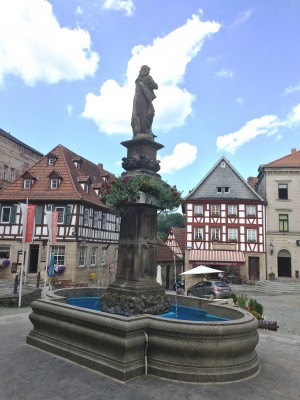
Fountain at Kronach Centrum,
Lucas Cranach the Elder was born in Kronach in 1472, and after his apprenticeship and journeyman years he lived and worked as a court painter to the Saxon Electors in Wittenberg from 1505.
His second son Lucas, who was in charge of the famous Cranach workshop from 1550, was born in 1515 and is buried in the Lutheran town
. Cranach the Elder spent his final years in Weimar.
The variety of works in the other cities attest to the active travels and creations of the two artists. Saxony-Anhalt celebrates Lucas Cranach the Younger in its 2015 State Exhibition Saxony-Anhalt, where the Reformation originated, was holding a state exhibition in 2015 on Lucas Cranach the Younger.
Seven exhibition projects in Wittenberg, Wörlitz and Dessau exemplified the multi-faceted work of the artist, who turned the issues of the day into stunning works of art in his own unique, visually stunning design language. As “CranachCity”, Wittenberg was celebrating the 500th anniversary of the native painter throughout the year.
Start in Nürnberg:
To go into these famouse painters, it is practically to start in Nürnberg, the city who after the second world war had got bombed 91 % of the city. Today 70 years after, Nürnberg is rebuild, and the city is looking beautiful, and full of memories from the hard time.
And the restored and rebuild houses gives an old fashion impression of how the city once could have been looking.
Interesting is it that due to that leaders of the city, perhaps had a feeling of that the then expected fast victory for Nazi Germany, not was going to be so successfully as others hoped.
Therefore they started discretely removing the citys valuable treasures of all sorts, down to deep caves situated under the Emperors fortress, and due to that, they managed to keep so many valuable treasures.But it had to be done in secret, nearly “no one” should know about it.
Albrecht Dürer
Albrecht Dürers home city is Nürnberg, a big part of the city, between the Emperors Fortress and down to the center of the old city has names related to Albrecht Dürer, In addition to the Albrecht Dürer house, where he lived, had his studio, restaurants, cafes, shops bears the names of Albrecht Dürer.
Link to Kulturkompasset official statistic: kulturkompasset.com/webalizer/index.html
